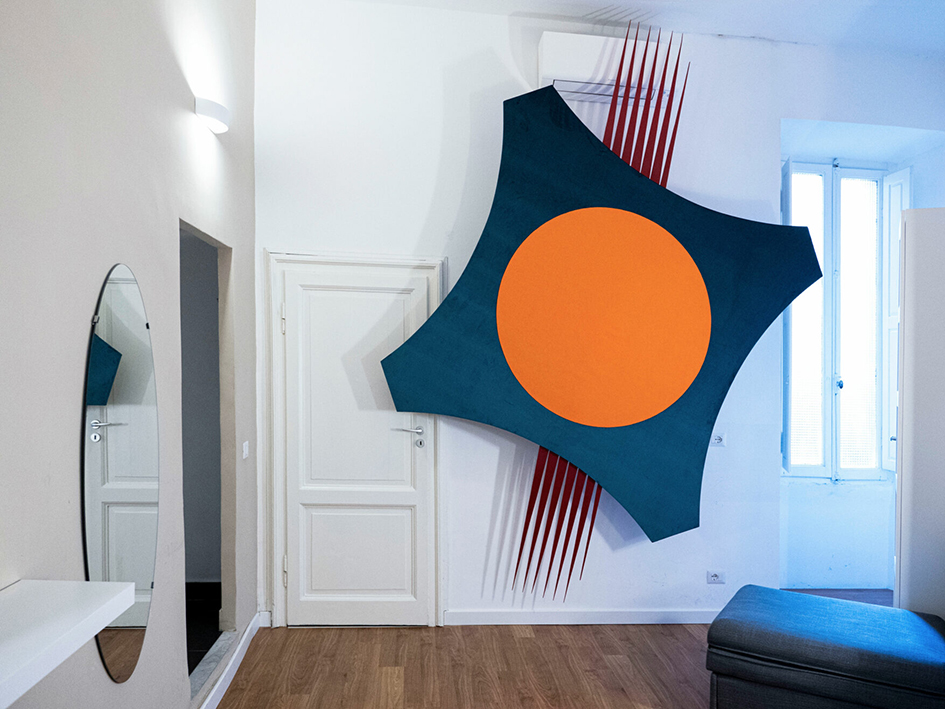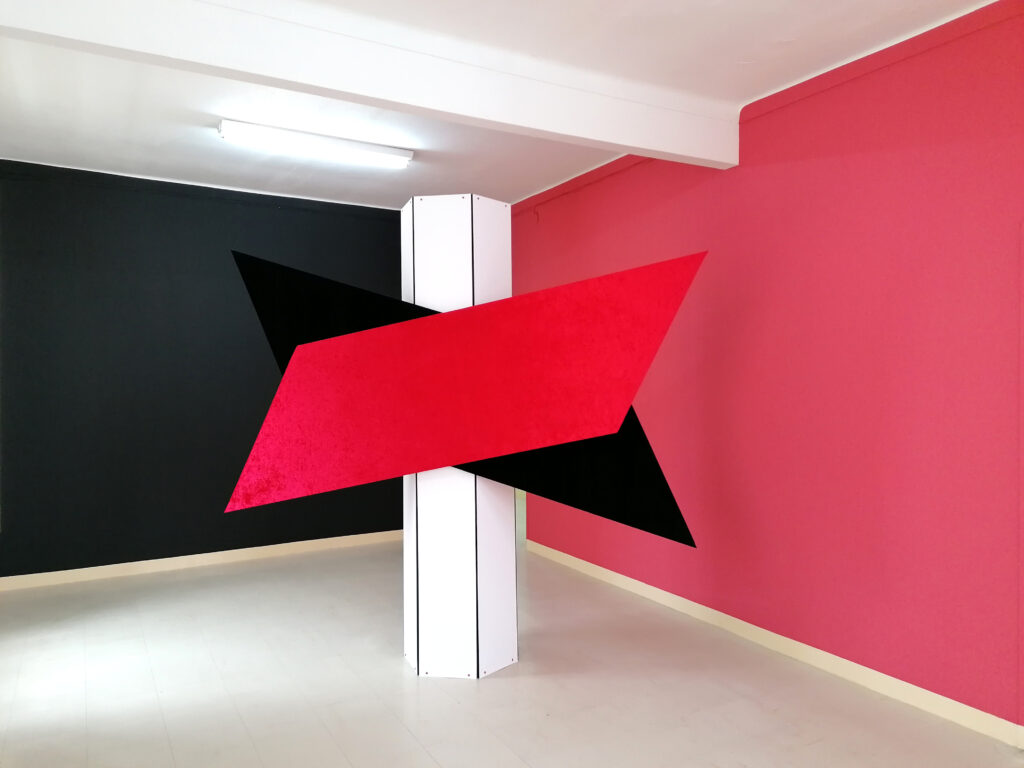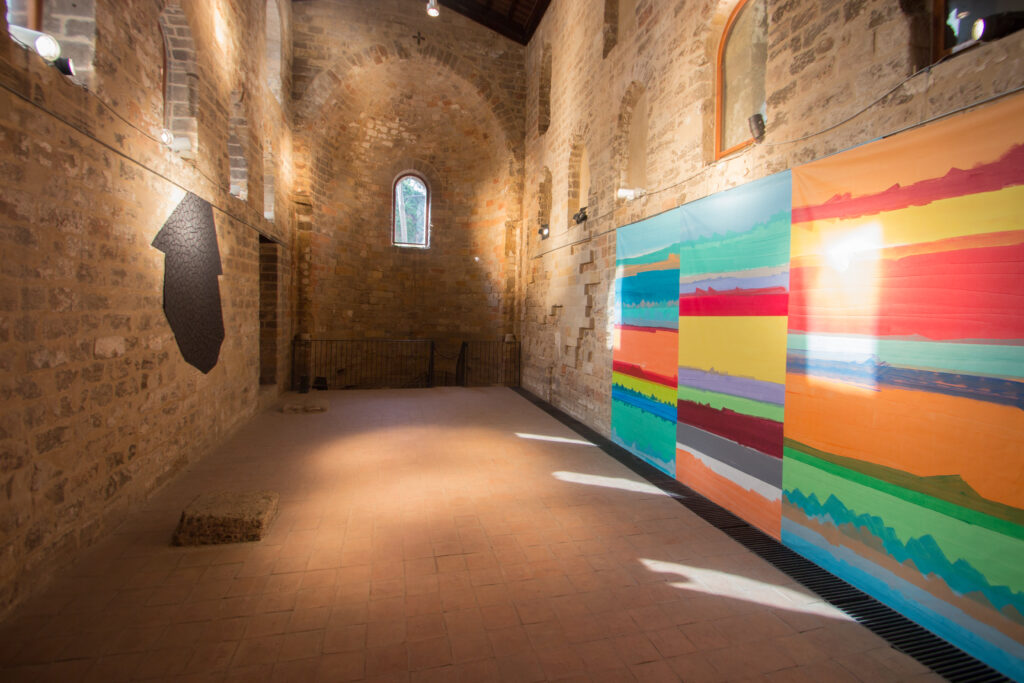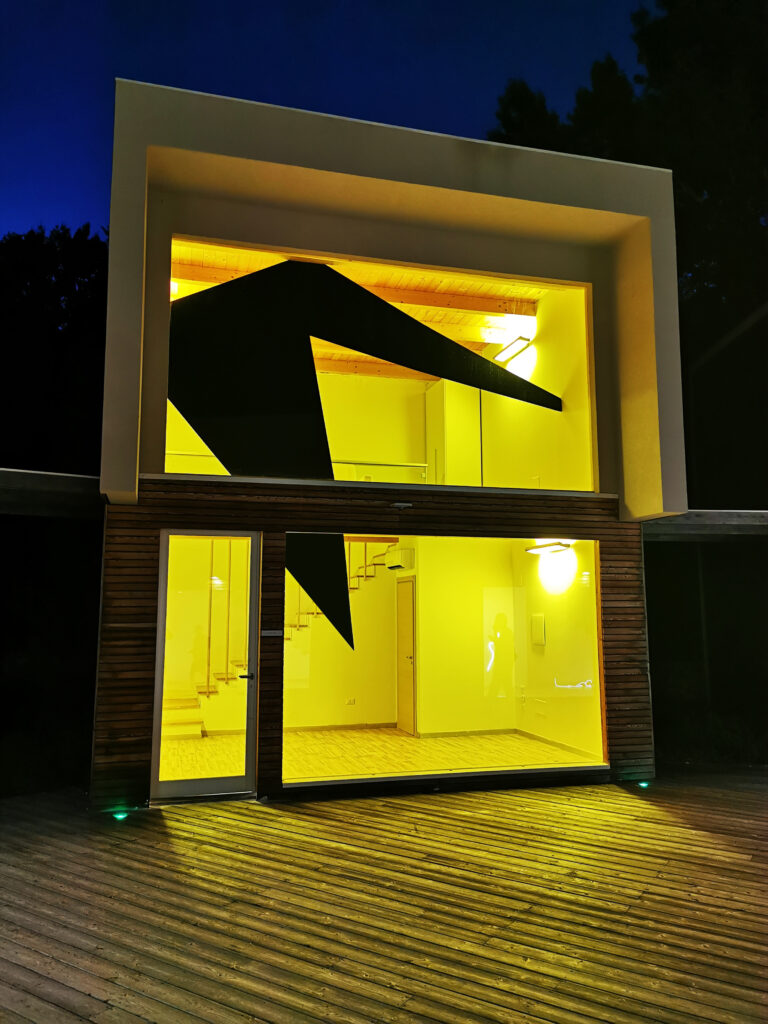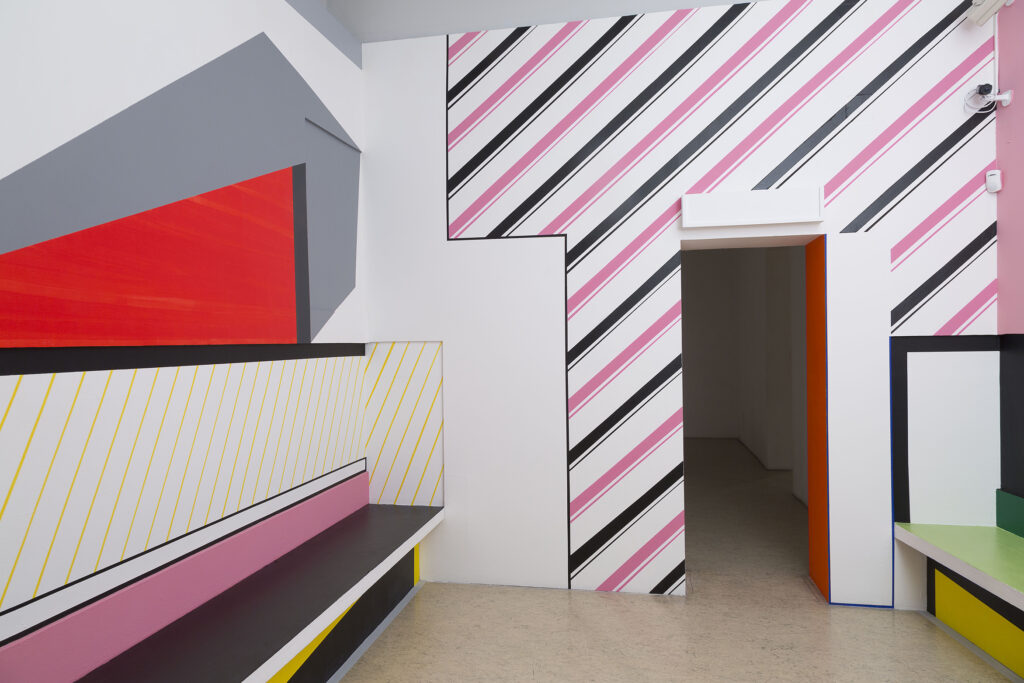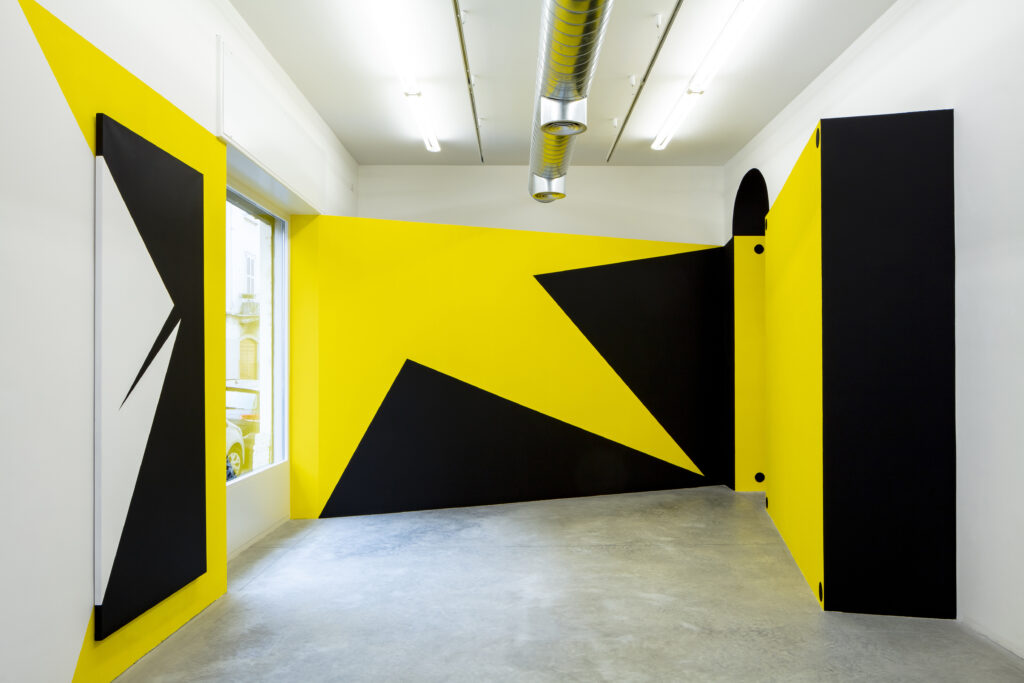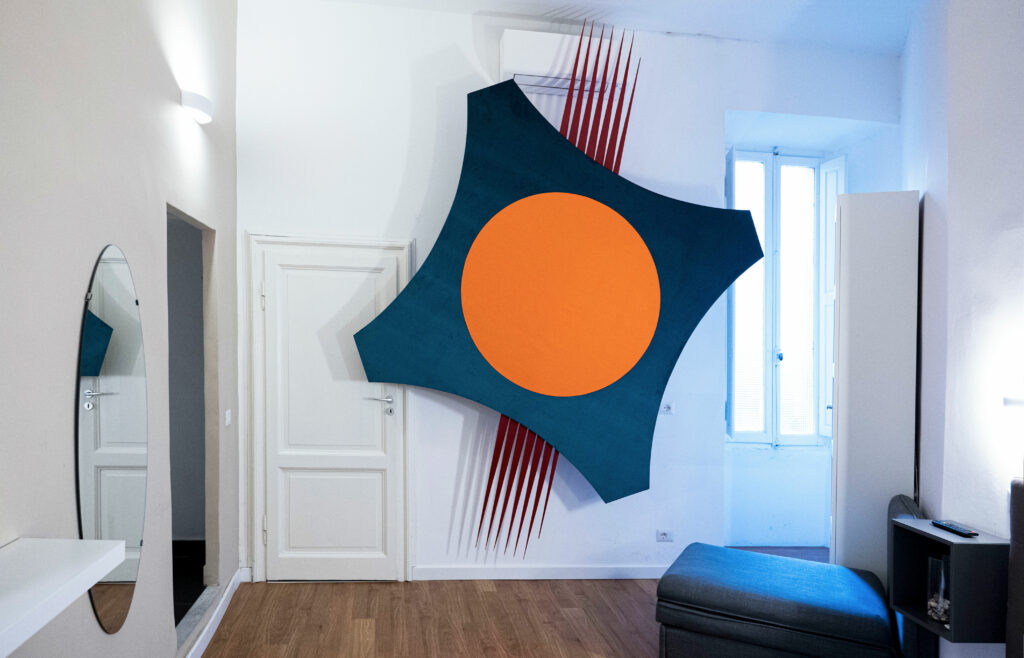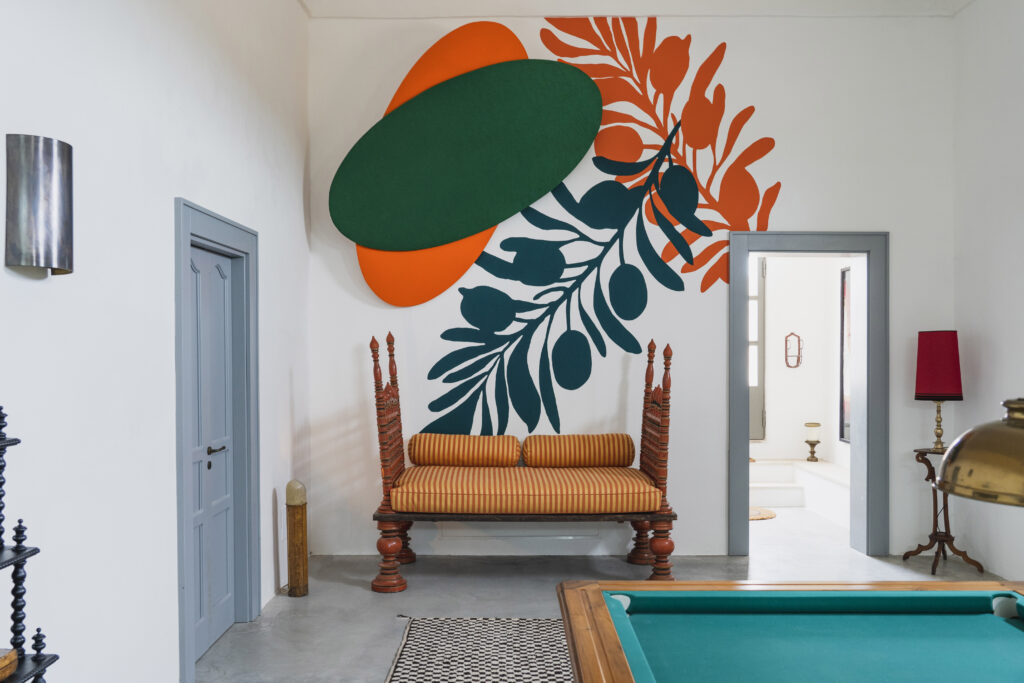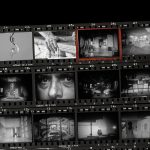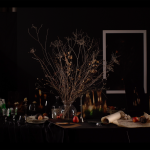english below
“Esperienze Sinestetiche : Genuardi / Ruta”
doppia intervista
Antonella Genuardi / Leonardo Ruta
__
Confinis
progetto a cura di Marco Tagliafierro
__
STRAORDINARIE TRASFIGURAZIONI TRA ESPERIENZE SINESTETICHE,
TRA PONDERAZIONI SENSORIALI E SINOPSIE LETTERARIE
Un viaggio nei colori, forme e luce dell’opera di Genuardi / Ruta,
due artisti che della Sicilia, luogo di nascita, hanno estrapolato l’essenza,
la sensibilità e la densità della cultura mediterranea.
Uno scambio aperto, diretto e sincero tra chi guarda nella stessa direzione.
Antonella Genuardi – La nostra decisione di lavorare come duo risale al 2014 all’Accademia di Belle Arti di Palermo. L’Osservatorio Arti Visive fu il luogo in cui si è definito e cristallizzato il nostro lavoro. Io ho sempre avuto una predilezione per il colore mentre tu per il segno e questo mi sembrava un ottimo presupposto per iniziare un percorso insieme. Le nostre prime riflessioni esaminavano alcuni degli elementi fondamentali per il Gruppo Forma 1: Forma, segno, colore. Non a caso molti dei componenti erano siciliani e credo ci sia una certa familiarità nell’intendere un colore. Direi una certa mediterraneità, intesa come modalità di visione. Per Camus il Mediterraneo è la ricerca della misura, in un dialogo tra il suo essere liquido, infinitamente mutevole e la terra. Luogo dove convivono Oriente e Occidente e l’identità che ne nasce dalla dialettica dei contrari. Queste le basi che continuano ad alimentare il nostro viaggio e che nel tempo ci hanno portato ad analizzare molti altri aspetti che oggi arricchiscono la ricerca.
Per Camus il Mediterraneo è la ricerca della misura, in un dialogo tra il suo essere liquido, infinitamente mutevole e la terra. Luogo dove convivono Oriente e Occidente e l’identità che ne nasce dalla dialettica dei contrari. Queste le basi che continuano ad alimentare il nostro viaggio e che nel tempo ci hanno portato ad analizzare molti altri aspetti che oggi arricchiscono la ricerca.
Penso alla luce delle tue zone, molto decisa, non trovi?
- Locomotive Breath, a cura di Jorge Reis, Casa Azul, Torres Vedras, Portogallo, 2020. Acrilico,legno, velluto, visione della mostra. PH Marisa Bernardes
Leonardo Ruta – Nelle zone del ragusano troviamo una luce più netta, più dura, una luce che definisco di confine e che ho trovato fin ora solo lì.
Nelle zone del ragusano troviamo una luce più netta, più dura, una luce che definisco di confine e che ho trovato fin ora solo lì.
I riflessi sui volumi architettonici costruiscono forme aguzze come spaccature; l’incontro della luce di mezzogiorno con l’oro e il rosa della pietra modicana dà vita a geometrie brillanti e sature.
Ricordo una finestra rossa che si affacciava su una pianura che si colorava di viola nelle belle stagioni; la luce talvolta era così forte da cancellare tutto con un bianco accecante. Nelle lunghe distese questa si insinua tra le fessure delle pietre dei muretti a secco che sembrano muoversi verso l’alto come serpenti ballanti poi oltre la collina dove si riapre un altro paesaggio. La Sicilia è un grande luogo di ispirazione, dalla malta ai pigmenti, alla convivenza tra diversi stili architettonici, è un luogo le cui bellezze si devono saper cogliere..
La Sicilia è un grande luogo di ispirazione, dalla malta ai pigmenti, alla convivenza tra diversi stili architettonici, è un luogo le cui bellezze si devono saper cogliere..
AG – Sono d’accordo. Le Corbusier ha appresso tantissimo dal suo viaggio nel Mediterraneo, il luogo per eccellenza dove cercare l’armonia delle forme, la gradazione della luce e la distribuzione dello spazio. Indiscusso padre dell’architettura moderna, è l’emblema di come il legame materico sia la stretta conseguenza di un significato simbolico. La filosofia dell’abitare è come per lui anche per noi questione molto cara, poiché dagli elementi razionali e poetici è l’esperienza il risultato finale. In tutto questo i colori sono una base fondamentale e lo capimmo già alla nostra prima personale. Fu un’esperienza unica, il nostro primo progetto insieme, non sapevamo come incastrare bene le nostre grammatiche, ricordi?
LR – Per la Cappella dell’Incoronazione abbiamo realizzato degli studi sul colore, sulla loro sovrapposizione e interazione. Superfici date da passaggi di colore tramite rulli di diversi tipi.
I colori costruiscono colore.
Per la Cappella dell’Incoronazione abbiamo realizzato degli studi sul colore, sulla loro sovrapposizione e interazione. Superfici date da passaggi di colore tramite rulli di diversi tipi.
I colori costruiscono colore.
- LATI, 2015, acrilico su tela, Visione della mostra, a cura di Osservatorio Arti Visive. Cappella dell'Incoronazione_Museo Riso, Palermo
Le varie superfici si intersecano e danno vita a delle dinamiche e delle tensioni che si aggrappano a quelle già presenti nello spazio. Il colore che entra dentro il colore sembra dar vita a delle cime, luoghi di origine minerale, gli stessi dai quali provengono i mattoni che strutturano lo spazio e diventano la pelle della sua stratificazione storica. Non avvertivi anche tu già l’esigenza di uscire dalla dimensione bidimensionale e rendere tutto lo spazio un quadro?
AG – Assolutamente sì, ci sono alcuni progetti che mi vengono in mente nei quali questo pensiero si è poi concretizzato: 3MV a Bocs Art Cosenza dove l’intera struttura in cui abitavamo è diventata, insieme al paesaggio circostante, un quadro.
3MV a Bocs Art Cosenza dove l’intera struttura in cui abitavamo è diventata, insieme al paesaggio circostante, un quadro.
- 3MV, 2019, tessuto, legno, luci colorate, visione della mostra Manabamate, a cura di Giacinto Di Pietrantonio, Bocs Art Residenze, Cosenza.
Anche Foresta in fiamme a Palermo vede l’intera stanza diventare opera totale, immersiva. In Locomotive Breath in Portogallo sembra invece di stare dentro The interior of the Grote Kerk at Harleem del pittore fiammingo Pieter Jansz Saenredam. Questa idea di ambiente ci affascina da sempre. Pensa a Wormhole a Milano, abbiamo trasformato i due spazi come fossero i due mondi paralleli dei quali si parla nel film Interstellar divisi solamente da un buco nero dove in uno dei due tutte le cose erano ingigantite. In quella occasione abbiamo immaginato come il colletto di un vestito potesse ingigantirsi talmente tanto da diventare un elemento dell’architettura.
- Foresta in fiamme, 2017, acrilico su parete, dimensioni ambientali, visione della mostra Attraverso i punti #2, a cura di Osseravtorio Arti Visive, Palazzo Ziino, Palermo. PH Sandro Scalia
Pensa a Wormhole a Milano, abbiamo trasformato i due spazi come fossero i due mondi paralleli dei quali si parla nel film Interstellar divisi solamente da un buco nero dove in uno dei due tutte le cose erano ingigantite. In quella occasione abbiamo immaginato come il colletto di un vestito potesse ingigantirsi talmente tanto da diventare un elemento dell’architettura.
- Wormhole, 2019, a cura di Samuel Gross, tessuti, acrilici e legno, visione della mostra. Francesco Pantaleone Arte Contemporanea Milano. PH Marco Beck Peccoz
Ma anche i recenti Sotto Verde Manto e Respiro il fresco cielo sono una riflessione sul rapporto tra l’uomo e lo spazio, sull’esperienza che viene vissuta, su come ci si muove intorno, sul proprio punto di vista e l’uso dei tessuti che abbiamo introdotto da qualche anno l’ha amplificata rendendola tattile.
- legno, feltro e velluto, visione della mostra Post-Turismo, a cura di Giuliana Benassi, Roma. ph. Ludovica Anzaldi
C’è sempre un’indagine architettonica nei nostri lavori. In fin dei conti se tu non avessi studiato in Accademia avresti scelto la Facoltà di Architettura, no?
LR – Alla fine del Liceo ho avuto questa indecisione, per istinto ho preso quella che ad oggi posso definire la scelta giusta . Mi affascina tantissimo il mondo dell’architettura anche perché ne ho appreso le basi elementari durante il Liceo. Ci confrontiamo spesso con alcune scelte stilistiche e tecnologiche di questo mondo e ne apprendiamo i dettagli. Facciamo tante citazioni ai grandi maestri contemporanei, da Carlo Scarpa a Pier Luigi Nervi nei nostri più recenti interventi spaziali; ma anche in maniera più sottile a Aires Mateus e Eduardo Souta De Moura che abbiamo avuto modo di approfondire durante il recente progetto di residenza in Portogallo conoscendo alcune delle maggiori opere\strutture da loro realizzate; comunque guardiamo soprattutto tutti coloro che hanno dato particolare importanza a dettaglio, forma e luce.
…comunque guardiamo soprattutto tutti coloro che hanno dato particolare importanza a dettaglio, forma e luce.
Ma per darti una risposta più completa e anche complessa ti direi che è stata Palermo a determinare questa mia scelta di percorso.. come fosse stata la città a darmi una risposta. Sento ci sia una grande complessità storica in questa città che ci cambia di continuo e ci aggiorna in maniera diversa rispetto a come succederebbe in altri grandi centri.
E’ fantastico guardare come la storia e le culture si siano stratificate e come ad oggi sentiamo, da artisti, l’esigenza di tirarle fuori per osservarle attraverso un progetto di natura pittorica.
E’ fantastico guardare come la storia e le culture si siano stratificate e come ad oggi sentiamo, da artisti, l’esigenza di tirarle fuori per osservarle attraverso un progetto di natura pittorica.
Detto questo direi che nel tempo questa fascinazione ci abbia portato ad avere un legame con questa terra quasi simbiotico portandoci a sentire l’esigenza di tutelarne il valore. Non pensi sia così? Guarda alla nostra decisione di vivere Palermo in una certa maniera, L’Ascensore e la nascente Casa Editrice..
AG – Chiaro, L’Ascensore è un prepulsore di incontri e scambi di visione, portare a Palermo gli artisti che stimiamo è per noi un fondamentale modo di dialogare con la nostra generazione attraverso le loro proposte e visioni. L’intento è proprio quello di arricchirci professionalmente e alimentare l’arte da una parte geografica precisa.
Palermo è un luogo che sta ai margini del sistema, ma produce energia che, se si vuole, serve ad alimentare il centro. Anche i margini producono le novità e Palermo è un margine di novità. Tutta la Sicilia è un brand, un’energia che devi saper cogliere, saper guardare perché non è a portata di mano. È più facile essere nella moda che essere fuori moda.
Tutta la Sicilia è un brand, un’energia che devi saper cogliere, saper guardare perché non è a portata di mano.
È più facile essere nella moda che essere fuori moda.
Anche la Casa Editrice che apriremo a breve avrà le stesse intenzioni ma sul piano umanistico. Mi piacerebbe che fosse un diario di bordo dei viaggiatori contemporanei in Sicilia anche se la prima pubblicazione sarà proprio il catalogo delle mostre fatte fin ora a L’Ascensore. Mi sembra un inizio perfetto per questa nuova avventura insieme, stavolta editoriale e poi vedremo quali altre idee ci verranno in mente…
LR – Chissà..
- Sotto Verde Manto, 2021, legno, velluto, ecopelle, visione della mostra, I.D.E.A. Salento, Masseria Canali, Casarano. PH Claudio Palma
“Synesthetic Experiences : Genuardi / Ruta”
conversation bewteen
Antonella Genuardi / Leonardo Ruta
__
Confinis
project by Marco Tagliafierro
__
EXTRAORDINARY TRANSFIGURATIONS BETWEEN SYNESTHETIC EXPERIENCES,
BETWEEN SENSORY PONDERINGS AND LITERARY SYNOPSES
A journey through the colours, shapes and light of the work of Genuardi / Ruta,
two artists who have extrapolated the essence,
sensitivity and density of Mediterranean culture from Sicily, their birthplace.
An open, direct and sincere exchange between those looking in the same direction.
Antonella Genuardi – Our decision to work as a duo dates back to 2014 at the Academy of Fine Arts in Palermo. The Visual Arts Observatory was the place where our work was defined and crystallized. I have always had a predilection for colour, you for the symbol, and this seemed to me an excellent assumption for starting a journey together. Our first reflections examined some of the fundamental elements of the Forma 1 Group: Shape, symbol, colour. It is no coincidence that many of the components were Sicilian, and I believe there is a certain familiarity in the understanding of colour. I would say a certain Mediterranean character, understood as a way of viewing. For Camus, the Mediterranean is the search for measure, in a dialogue between its liquid, infinitely changing being and the earth. A place where East and West coexist, and an identity that arises from the dialectic of opposites. These are the foundations that continue to fuel our journey and that over time have led us to analyse many other aspects that enrich our research today.
For Camus, the Mediterranean is the search for measure, in a dialogue between its liquid, infinitely changing being and the earth. A place where East and West coexist, and an identity that arises from the dialectic of opposites. These are the foundations that continue to fuel our journey and that over time have led us to analyse many other aspects that enrich our research today.
I think in the light of your areas, this is very determined, don’t you agree?
- Locomotive Breath, a cura di Jorge Reis, Casa Azul, Torres Vedras, Portogallo, 2020. Acrilico,legno, velluto, visione della mostra. PH Marisa Bernardes
Leonardo Ruta – In the areas of Ragusa we find a clearer, harder light, a light that I define as a borderline and that, so far, I have only found there.
In the areas of Ragusa we find a clearer, harder light, a light that I define as a borderline and that, so far, I have only found there.
The reflections on the architectural masses construct sharp forms like cracks; the meeting of the midday light with the gold and pink of the Modica stone gives life to bright and saturated geometries.
I remember a red window that overlooked a plain that had a purple colour in good weather; the light was sometimes so strong that it blotted out everything with a blinding white. In the long expanses this creeps between the cracks in the stones of the dry stone walls that seem to move upwards like dancing snakes, then over the hill where another landscape reopens. Sicily is a great place of inspiration, from mortar to pigments, to the coexistence of different architectural styles, it is a place whose beauties you must be able to grasp.
Sicily is a great place of inspiration, from mortar to pigments, to the coexistence of different architectural styles, it is a place whose beauties you must be able to grasp.
AG – I agree. Le Corbusier learned a lot from his trip to the Mediterranean, the place par excellence for seeking the harmony of forms, the gradation of light and the distribution of space. Undisputed father of modern architecture, he is the emblem of how the material bond is the close consequence of symbolic meaning. The philosophy of living is, as it was for him, a very important issue for us too, since the final result comes from the experience of rational and poetic elements. In all this, colours are of fundamental importance, as we already understood in our first solo show. It was a unique experience, our first project together, we didn’t know how to fit our grammars together well, remember?
LR – For the Coronation Chapel, we carried out studies on colour, on the overlap and interaction. Surfaces created by passing colours through different types of roller.
Colours create colour.
For the Coronation Chapel, we carried out studies on colour, on the overlap and interaction. Surfaces created by passing colours through different types of roller.
Colours create colour.
- LATI, 2015, acrilico su tela, Visione della mostra, a cura di Osservatorio Arti Visive. Cappella dell'Incoronazione_Museo Riso, Palermo
The various surfaces intersect and give life to dynamics and tensions which cling to those already present in the space. The colour that enters the colour seems to give life to peaks, places of mineral origin, the same from which the bricks that structure the space come from to become the skin of its historical stratification. Didn’t you already feel the need to leave the two-dimensional dimension and make the whole space into a painting?
AG – Absolutely yes, there are some projects that come to my mind in which this thought materialized: 3MV in Bocs Art Cosenza where the entire structure in which we lived became, together with the surrounding landscape, a painting.
3MV in Bocs Art Cosenza where the entire structure in which we lived became, together with the surrounding landscape, a painting.
- 3MV, 2019, tessuto, legno, luci colorate, visione della mostra Manabamate, a cura di Giacinto Di Pietrantonio, Bocs Art Residenze, Cosenza.
Forest in flames in Palermo also sees the entire room become a total, immersive work. In Locomotive Breath in Portugal we seem to be inside The interior of the Grote Kerk at Harleem by the Flemish painter Pieter Jansz Saenredam. We have always been fascinated by this idea of an environment. Think of Wormhole in Milan, we transformed the two spaces as if they were the two parallel worlds spoken of in the film Interstellar, separated only by a black hole, where in one of the two all things were magnified. On that occasion, we imagined how the collar of a dress could grow so big that it became an element of architecture.
- Foresta in fiamme, 2017, acrilico su parete, dimensioni ambientali, visione della mostra Attraverso i punti #2, a cura di Osseravtorio Arti Visive, Palazzo Ziino, Palermo. PH Sandro Scalia
Think of Wormhole in Milan, we transformed the two spaces as if they were the two parallel worlds spoken of in the film Interstellar, separated only by a black hole, where in one of the two all things were magnified. On that occasion, we imagined how the collar of a dress could grow so big that it became an element of architecture.
- Wormhole, 2019, a cura di Samuel Gross, tessuti, acrilici e legno, visione della mostra. Francesco Pantaleone Arte Contemporanea Milano. PH Marco Beck Peccoz
But also the recent Under A Green Mantle and Breathe the Cool Sky are a reflection on the relationship between man and space, on the experience that is lived, on how one moves around, on one’s point of view; and the use of fabrics that we introduced a few years ago amplified it by making it tactile.
- legno, feltro e velluto, visione della mostra Post-Turismo, a cura di Giuliana Benassi, Roma. ph. Ludovica Anzaldi
There is always an architectural element in our works. After all, if you hadn’t studied at the Academy, you would have chosen the Faculty of Architecture, right?
LR – At the end of high school I was undecided, by instinct I took what today I can define the right choice. The world of architecture fascinates me a lot also because I learned its elementary basics during high school. We often deal with some of stylistic and technological choices of this world and we learn the details. We make many references to the great contemporary masters, from Carlo Scarpa to Pier Luigi Nervi in our most recent spatial interventions; but also in a more subtle way to Aires Mateus and Eduardo Souta De Moura, of whomw we had the opportunity to deepen our awareness during the recent residency project in Portugal, getting to know some of the major works \ structures they created; however, we look above all to all those who have given particular importance to detail, shape and light.
…however, we look above all to all those who have given particular importance to detail, shape and light.
But to give you a more complete and even complex answer, I would tell you that it was Palermo that determined my choice of path … as if the city had given me an answer. I feel there is a great historical complexity in this city that changes us constantly and updates us in a different way compared to how it would happen in other large urban centres.
It is fantastic to see how history and cultures have stratified and how today we feel, as artists, the need to bring them out to observe them through an artistic project.
It is fantastic to see how history and cultures have stratified and how today we feel, as artists, the need to bring them out to observe them through an artistic project.
Having said that, I would say that over time this fascination has led us to have an almost symbiotic bond with this land, leading us to feel the need to protect its merit. Don’t you think that’s the case? Look at our decision to experience Palermo in a certain way, the Elevator and the nascent Publishing House…
AG – Of course, the Elevator is a forerunner of encounters and exchanges of vision. Bringing the artists we esteem to Palermo is a fundamental way for us to communicate with our generation through their suggestions and visions. The intention is exactly that of enriching ourselves professionally and nurturing art from a specific geographic area.
Palermo is a place that is on the edge of the system, but which produces energy that, if desired, can serve to power the centre. Even the margins produce new things, and Palermo is a margin of novelty. All of Sicily is a brand, an energy that you must be able to grasp, to know how to look at because it is not at hand. It is easier to be in style than to be out of style.
All of Sicily is a brand, an energy that you must be able to grasp, to know how to look at because it is not at hand. It is easier to be in style than to be out of style.
Even the publishing house that we will open shortly will have the same intentions but on a humanist level. I would like it to be a logbook of contemporary travelers in Sicily, even if the first publication will be the catalogue of the exhibitions held so far at the Elevator. It seems to me to be a perfect start for this new adventure together, in publishing this time, and then we’ll see what other ideas come to mind …
LR – Who knows..
- Sotto Verde Manto, 2021, legno, velluto, ecopelle, visione della mostra, I.D.E.A. Salento, Masseria Canali, Casarano. PH Claudio Palma

